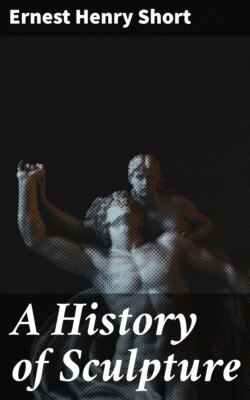A History of Sculpture

Реклама. ООО «ЛитРес», ИНН: 7719571260.
Оглавление
Ernest Henry Short. A History of Sculpture
A History of Sculpture
Table of Contents
PREFACE
LIST OF PLATES
PART I. HELLENIC SCULPTURE
CHAPTER I
THE EARLY BEGINNINGS (1000 b.c. TO 550 b.c.)
THE GROWTH OF NATURALISM (550 b.c. TO 480 b.c.)
THE ATHLETIC SCULPTURES (480 b.c. TO 400 b.c.)
THE OLYMPIAN GAMES
CHAPTER II
THE PARTHENON
THE TEMPLE STATUARY
CHAPTER III
THE AGE OF SCOPAS (400 b.c.-350 b.c.)
THE AGE OF PRAXITELES (360 b.c.-325 b.c.)
THE INFLUENCE OF GREEK WOMANHOOD
CHAPTER IV
MODERN SCULPTURAL CRITICISM
GREEK PORTRAITURE
PART II. HELLENISTIC AND ROMAN SCULPTURE
CHAPTER V
THE EMPIRE OF SELEUCUS (301 b.c. TO 65 b.c.)
THE KINGDOM OF PERGAMUS (283 b.c. TO 133 b.c.)
THE SCULPTURE OF RHODES AND ALEXANDRIA (300 b.c. TO 50 b.c.)
CHAPTER VI
THE FOLLOWERS OF LYSIPPUS
THE FOLLOWERS OF PRAXITELES
CHAPTER VII
THE GRÆCO-ROMAN SCULPTORS
THE RISE OF ROMAN PORTRAITURE
THE HEIGHT OF ROMAN IMPERIALISM (96 a.d. TO 117 a.d.)
THE REACTION UNDER HADRIAN (117 a.d. TO 138 a.d.)
POST-HADRIAN SCULPTURE
PART III. THE SCULPTURE OF THE ITALIAN RENAISSANCE
CHAPTER VIII
THE GOTHIC SCULPTORS
THE PISANI
CHAPTER IX
GHIBERTI AND THE GATES OF. THE FLORENTINE BAPTISTERY
DONATELLO AND THE CHURCH OF. OR SAN MICHELE
THE INFLUENCE OF THE PLATONISTS
CHAPTER X
THE FLORENTINE PERIOD
THE MEDICI TOMBS
CHAPTER XI
BENVENUTO CELLINI
BERNINI AND THE CATHOLIC REACTION
PART IV. MODERN SCULPTURE
CHAPTER XII
THE AGE OF FRANCIS I
THE AGE OF LOUIS QUATORZE
THE EIGHTEENTH CENTURY
CHAPTER XIII
CANOVA AND THORVALDSEN
THE SCULPTURE OF THE FRENCH REVOLUTION
THE RISE OF ENGLISH SCULPTURE
CHAPTER XIV
THE ACADEMIC SCULPTORS
AUGUSTE RODIN
CHAPTER XV
THE RISE OF NATURALISM
THE GROWTH OF INDIVIDUALISM
LIST OF BOOKS
INDEX
Отрывок из книги
Ernest Henry Short
Published by Good Press, 2021
.....
The mention of Myron, the earliest artist to benefit by the freeing of the plastic arts from the shackles of conventionalism, brings us upon one of the prime problems of Greek sculpture. Practically, the history of Greek sculpture depends upon the connections which can be established between the art and three leading ideals. The difficulty of really understanding it depends upon the distance we moderns have progressed—pardon us the term—from those three dominating ideas.
“How we jabber about the Greeks! What do we understand of their art, the soul of which is the passion for naked male beauty?” So says Nietzsche. And he proceeds to point out that for this very reason the Greeks had a perspective altogether different from our own. Nothing can be truer; nor can anything be more certain than that this truth must be realised absolutely by all who would penetrate beyond the outer courts of the temple of Hellenic sculpture. But though we cannot look at a Greek statue with the understanding of a Hellene, though classic sculpture is, as it were, written in an alien tongue, the historian can readily enumerate the influences by which the art was fostered, and the ideals which it sought to embody.
.....